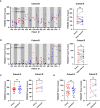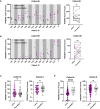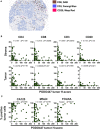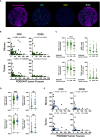A tumor-restricted glycoform of podocalyxin is a highly selective marker of immunologically cold high-grade serous ovarian carcinoma
- PMID: 38188285
- PMCID: PMC10771318
- DOI: 10.3389/fonc.2023.1286754
A tumor-restricted glycoform of podocalyxin is a highly selective marker of immunologically cold high-grade serous ovarian carcinoma
Abstract
Introduction: Targeted-immunotherapies such as antibody-drug conjugates (ADC), chimeric antigen receptor (CAR) T cells or bispecific T-cell engagers (eg, BiTE®) all aim to improve cancer treatment by directly targeting cancer cells while sparing healthy tissues. Success of these therapies requires tumor antigens that are abundantly expressed and, ideally, tumor specific. The CD34-related stem cell sialomucin, podocalyxin (PODXL), is a promising target as it is overexpressed on a variety of tumor types and its expression is consistently linked to poor prognosis. However, PODXL is also expressed in healthy tissues including kidney podocytes and endothelia. To circumvent this potential pitfall, we developed an antibody, named PODO447, that selectively targets a tumor-associated glycoform of PODXL. This tumor glycoepitope is expressed by 65% of high-grade serous ovarian carcinoma (HGSOC) tumors.
Methods: In this study we characterize these PODO447-expressing tumors as a distinct subset of HGSOC using four different patient cohorts that include pre-chemotherapy, post-neoadjuvant chemotherapy (NACT) and relapsing tumors as well as tumors from various peritoneal locations.
Results: We find that the PODO447 epitope expression is similar across tumor locations and negligibly impacted by chemotherapy. Invariably, tumors with high levels of the PODO447 epitope lack infiltrating CD8+ T cells and CD20+ B cells/plasma cells, an immune phenotype consistently associated with poor outcome.
Discussion: We conclude that the PODO447 glycoepitope is an excellent biomarker of immune "cold" tumors and a candidate for the development of targeted-therapies for these hard-to-treat cancers.
Keywords: glycoepitope; high-grade serous ovarian carcinoma; immune cold; immunotherapy; podocalyxin.
Copyright © 2023 Brassard, Hughes, Dean, Hernaez, Thornton, Banville, Smazynski, Warren, Zhang, Milne, Gilks, Mes-Masson, Huntsman, Nelson, Roskelley and McNagny.
Conflict of interest statement
Authors MH, PD, KM and CR hold patents for the PODXL antibodies described in this manuscript including issued US Patents US11090383B2, US11390673B2. KM and CR hold a patent claiming methods for detecting and treating cancer related to podocalyxin US9309323B2. The remaining authors declare that the research was conducted in the absence of any commercial or financial relationships that could be construed as a potential conflict of interest.
Figures






Similar articles
-
PODO447: a novel antibody to a tumor-restricted epitope on the cancer antigen podocalyxin.J Immunother Cancer. 2020 Nov;8(2):e001128. doi: 10.1136/jitc-2020-001128. J Immunother Cancer. 2020. PMID: 33243933 Free PMC article.
-
Targeting a Tumor-Specific Epitope on Podocalyxin Increases Survival in Human Tumor Preclinical Models.Front Oncol. 2022 May 4;12:856424. doi: 10.3389/fonc.2022.856424. eCollection 2022. Front Oncol. 2022. PMID: 35600398 Free PMC article.
-
Co-expression patterns of chimeric antigen receptor (CAR)-T cell target antigens in primary and recurrent ovarian cancer.Gynecol Oncol. 2021 Feb;160(2):520-529. doi: 10.1016/j.ygyno.2020.12.005. Epub 2020 Dec 17. Gynecol Oncol. 2021. PMID: 33342620
-
Podocalyxin in Normal Tissue and Epithelial Cancer.Cancers (Basel). 2021 Jun 8;13(12):2863. doi: 10.3390/cancers13122863. Cancers (Basel). 2021. PMID: 34201212 Free PMC article. Review.
-
Antibody-Drug Conjugates Targeting Tumor-Specific Mucin Glycoepitopes.Front Biosci (Landmark Ed). 2022 Nov 4;27(11):301. doi: 10.31083/j.fbl2711301. Front Biosci (Landmark Ed). 2022. PMID: 36472102 Review.
Cited by
-
Single-cell RNA sequencing reveals the change in cytotoxic NK/T cells, epithelial cells and myeloid cells of the tumor microenvironment of high-grade serous ovarian carcinoma.Discov Oncol. 2024 Sep 9;15(1):417. doi: 10.1007/s12672-024-01290-9. Discov Oncol. 2024. PMID: 39249551 Free PMC article.
References
Grants and funding
LinkOut - more resources
Full Text Sources
Research Materials

